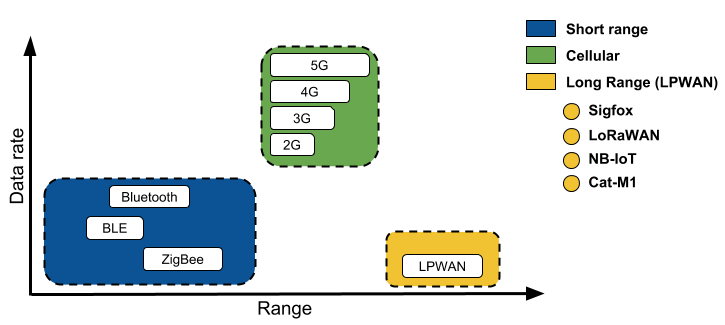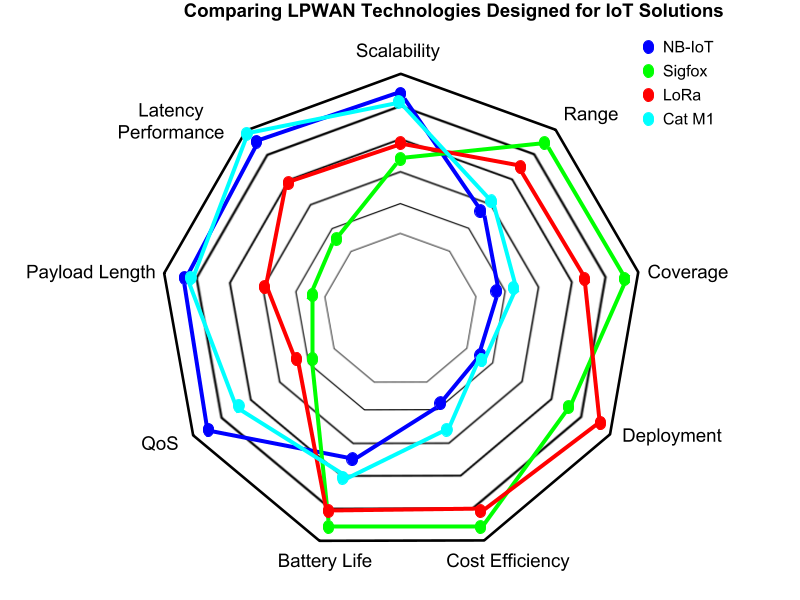Connectivity Now and Beyond; exploring Cat-M1, NB-IoT, and LPWAN Connections

If you are connecting devices (sensors, actuators, beacons, or gateways) to the internet, you are building an Internet of Things solution. Although this is not a new concept, the expanding access to the internet, mainly the cloud, mixed with lower hardware and connectivity costs, IoT Solutions – also known as IoT Applications – are more available than ever. The value-add these solutions bring to everyday work and life begins with how a sensor or gateway connects to the internet. To choose the best connectivity for an IoT Solution is paramount to an Apps success. In this article, we will explore technologies that get data to the internet.
Devices connect to the internet in two ways: wired or wireless. Commonly used in Industrial environments, Ethernet was the wired solution of choice for decades to collect data in all types of monitoring applications. Then, in the 1990s came a huge advancement with the delivery of WiFi and Radio technologies like ZigBee and Bluetooth, leaving the wires behind and unlocking new forms of data collection for industries to adopt. In line with the advancements of WiFi, so too were the advancements in cellular communication infrastructures like 2G, 3G, and then 4G (coming soon – 5G) which offer the combination of higher speeds and coverage. As good and reliable as these connectivity types are, they all have the major pain-point of excessive energy requirements to transmit data to the internet.

In search of a better solution, entrepreneurs and industry leaders raced to what they believed would become the perfect solution for IoT applications. The result of this data transmission race is now known as LPWAN (low power wide area network). Designed specifically to allow long-range communications up to 10-40 km in rural zones and 1-5 km in urban zones, LPWAN devices typically carry a battery life of 4+ years thanks to energy saving coding called sleep mode. Some immediate externalities of LPWAN include immense cost savings (thanks to lack of wires), simpler application development and operating costs (in part, thanks to the advancement of decentralized networks which was developed in tandem with connectivity advancements), and a greater range to serve rural applications for businesses, safety organizations, and researchers. With LPWAN, hardware can be where people cannot.
In 2009, Sigfox came onto the scene to deliver an LPWAN connection as a private organization and could not be ignored by cellular network competition. After a few years of private development, the cellular carriers like Verizon and T-Mobile began deploying their own solutions, LTE Cat-M and NB-IoT respectively, for low power IoT device connectivity options.
Sigfox is an LPWAN network operator that offers device-to-cloud IoT connectivity coverage in 45 countries and regions. The Sigfox network consists of privately deployed proprietary base stations located in different regions of the globe which can receive messages (raw data) from devices over a radio frequency. The Sigfox network connects field devices to a back-end cloud server clusters using an IP based network. Once the message is sent from the device to the base station and received in the Sigfox backend, users are able to manage the data received with different IoT Enablement Platforms using HTTP callbacks or the Sigfox API. Sigfox supports bidirectional communication but is severely limited in daily communication capabilities: uplink messages are limited to 140 messages and downlink messages limited to 4 messages for the largest subscription size. Also, the maximum size per uplink message is 12 bytes (not too big).

With these constraints, Sigfox is no doubt a low power consumption solution for IoT field applications and perfect for AgTech and Remote Condition Monitoring. Sigfox is a good option for low-cost IoT hardware and low energy consumption to send data over long ranges (when there is coverage in the area).
The key features of Sigfox include
- High QoS: A device is not attached to a specific base station. Its broadcasted messages are received by any base station in the range, which is 3 on average, and there is no need for message acknowledgment. Spatial diversity coupled with time and frequency diversity of radio frame repetitions lead to high quality of service of the Sigfox network.
- High resilience to interferences:UNB intrinsic ruggedness coupled with a spatial diversity of the base stations offer great anti-jamming capabilities. UNB is extremely robust in an environment with spread spectrum signals. UNB is the best choice to operate on the public ISM band.
- Very long range: Low bit rate and simple radio modulation enable a 163.3 dB budget link for long-range communications.
- High energy efficiency: Sigfox radio protocol cuts the radio frame size down and no synchronization with the network is required. Combining a low power emission level and short emission duration (less than one minute per day) allows maximum autonomy to devices.
- High network capacity: The small footprint of UNB enables more simultaneous signals within the operating band, in addition, Sigfox protocol cuts down the radio frames size. Those two features combined with the use of cognitive radio technology enables the Sigfox network to reach a high capacity. (Source: sigfox.com)
In parallel to Sigfox’s advancements, the LoRa protocol (Long range) was also developed. LoRa, also an LPWAN technology, specifies a physical layer that modulates the signal using a proprietary spread spectrum technique. LoRa uses unlicensed ISM bands, allowing customers to create an open network, without the need for authorization from radio frequency regulators. The chirp spread spectrum (CSS) modulation spreads a narrow-band signal over a wider channel bandwidth providing bidirectional communication. LoRa uses six spreading factors where the messages are transmitted and received simultaneously by LoRa base stations with a maximum size per message of 246 bytes.
As Sigfox and LoRA grew they needed to be contained so individuals, businesses, and governments could rely on a connection type that was standardized and controlled. To achieve this, in 2015 a LoRa-based communication protocol was standardized by the then created LoRa-Alliance. This standardized LoRa protocol became known as LoRaWAN and is a network protocol that uses LoRa technology to communicate and manage hardware (nodes and gateways) in remote locations. The nodes are end-devices which send and receive data to/from the gateway which manages and pushes messages to a LoRaWAN network server pre-configured into the gateway.
The key features of the LoRa and LoRaWAN protocols include
- Low cost: Reduces costs three ways: infrastructure investment, operating expenses and end-node sensors
- Standardized: Improved global interoperability speed adoption and roll out of LoRaWAN-based networks and IoT applications
- Low power: Protocol designed specifically for low power consumption extending battery life up to 20 years
- Long range: Single base station provides deep penetration in dense urban/indoor regions. In theory, in rural areas, the range is up to 30 miles. We at Ubidots have tested LoRa radios in urban areas and achieved distances up to 1 mile with basic 900 MHz antennas.
- Secure: Embedded end-to-end AES128 encryption
- High capacity: Supports millions of messages per base station, ideal for public network operators serving many customers
More recently the competition amongst cellular providers and LoRa solutions came to a head with the releases of Verizon’s Cat-M1 service and T-Mobile’s Narrowband IoT (NB-IoT) network. Beginning with Verizon’s Cat-M or LTE Cat-M1, a low-power wide-area (LPWA) connectivity optimized for IoT and M2M devices. Cat-M is ideal for solutions with medium data rate requirements – 375 kb/s upload and download speeds in half-duplex mode with a maximum message size of 1500 bytes in a 2-way data communication. At these speeds, LTE Cat-M1 delivers remote firmware updates over-the-air (FOTA) within reasonable timeframes, improving maintenance and hardware support for hardware deployed in rural areas. Because Cat-M1 was designed with IoT efficiency in mind, hardware requirements for data rate, range, latency, and upload & download speed have become the focus points to strengthen cellular’s battle with LoRa technology.
Like many releases made by competing cellular providers, T-Mobile soon followed Verizon’s release with their own dubbed NB-IoT which enables a wide range of IoT devices and services using cellular telecommunications towers, coexisting with GSM and LTE under the licensed frequency bands. NB-IoT offers a data rate requirement of ~50kb/s upload and download speeds in half-duplex mode. Also, it connects devices efficiently on already established mobile networks, can handle a maximum message size 1600 bytes in 2-way data communication, improves power consumption requirements of the end-devices, and provides an excellent extended range in buildings or underground – things that LoRa and standard cellular will struggle with.
Comparing NB-IoT with LTE Cat M1, both take and handle data between cellular towers, similar to high speeds LTE. The main difference between these connection types is how moving devices data is communicated to the internet when in motion. If a device moves from point A to a far away point B, crossing several different networks cells, the Cat M1 device would never drop the connection because it behaves the same as a cell phone, connecting from tower-to-tower as it moves. NB-IoT devices, on the other hand, do not transfer the connection and instead have to re‑establish a new connection to a new cellular tower each time a tower is lost and a new tower is detected.
The below diagram compares LPWAN technologies designed for IoT solutions.

Based on this diagram, technical differences and suitability for different kind of applications can be optimized with the correct connectivity. For example:
- In Smart Farming applications, LPWAN technologies stand out because of long range and battery life capabilities. However, LoRa may be the better fit in cases where no Sigfox coverage is present.
- In the Manufacturing and AutomatioN world:
- For real-time machinery monitoring, the good old connections such as Ethernet or WiFi are still ideal options – at least for factories that already offer Internet access. However, for remote industrial environments, such as remote tanks, pipes, and/or turbines NB-IoT is a fitting choice because it promises increased reliability and regularity for data transmission compared to Sigfox.
- Applications like asset tracking or status monitoring are ideal for Sigfox, were coverage is available, or LTE Cat-M in cases where the asset will change its location (i.e. semi-truck or tanker tracking).
- In Smart Building applications, where different variables like temperature, humidity, water flow, electric consumption, etc… can be used to alert property management of preventative measure for critical machinery or systems. Sigfox is a great option because it saves you the cost and effort of installing and maintaining a gateway per building, however, beware of the signal penetration as it can be poor in basements floors or the center of buildings. If, after running a Sigfox signal test you can’t get coverage, then LoRa will be the knight in shining armor to solve the penetration problems.
In conclusion, the ideal connectivity type for your Internet-connected solution/application is best based on the environment that your device is living and how large your data payload will be. For a low-cost device with long-range capabilities and smaller payloads, we recommend a LoRa or Sigfox solution (if Sigfox is deployed in your area). And, as the NB-IoT and Cat-M1 networks continue to be deployed across service areas, their attraction and services will continue to improve making these options equally as valuable as their predecessors like 2G and 3G, but with lower cost and greater energy efficiency. Lastly, for applications that require high data rates or use hardware that consumes a lot of energy, the tried and true WiFi or wired solution of Ethernet are still the most suitable.
To continue learning ways to communicate your data with the internet, join Ubidots newsletter and check out Ubidots Blog which is regularly updated with great IoT Development and Deployment materials to help you connect the dots to the Internet of Things.

